Nuno Espírito Santo’s tactical approach with Nottingham Forest is reshaping the team’s style of play, introducing a blend of defensive resilience and disciplined structure. Known for his ability to organize squads and maximize collective strengths, Espírito Santo has brought a unique system to Forest, emphasizing compact formations, quick transitions, and calculated offensive strategies. This analysis dives into how his tactical choices are influencing Nottingham Forest’s performance on both sides of the pitch, offering insights into the adjustments, patterns, and methods that define his game plan.
Build-up
Espírito Santo usually sets his team up in a 1-4-2-3-1 formation in the build-up, with a back four, two holding midfielders, one number-ten, two wingers, and a striker up front.

Building up in a 1-4-2-3-1 formation focuses on creating a stable and flexible structure to facilitate ball progression from defense to attack. The four defenders provide a solid backline, with the fullbacks often pushing up to offer width. The two holding midfielders play a crucial role, acting as a pivot to distribute the ball and shield the defense. The three attacking midfielders, positioned centrally and on the wings, aim to exploit spaces between the opposition’s lines, supporting the lone striker who leads the attack. This formation allows for versatility in passing options, with the team able to switch play, build through the center, or exploit wide areas, making it effective for controlling possession and launching varied attacking moves.
Rotations and Fluidity
The Nottingham Forest players constantly rotate during the build-up. The team adopts a dynamic approach, shifting between formations to create numerical advantages and exploit spaces. Espírito Santo’s focus is always to get the players into their best positions, where they can make the most out of their individual skills. Wingers like Anthony Elanga and Callum Hudson Odoi, who are at their best on the wing, stay wide in possession.
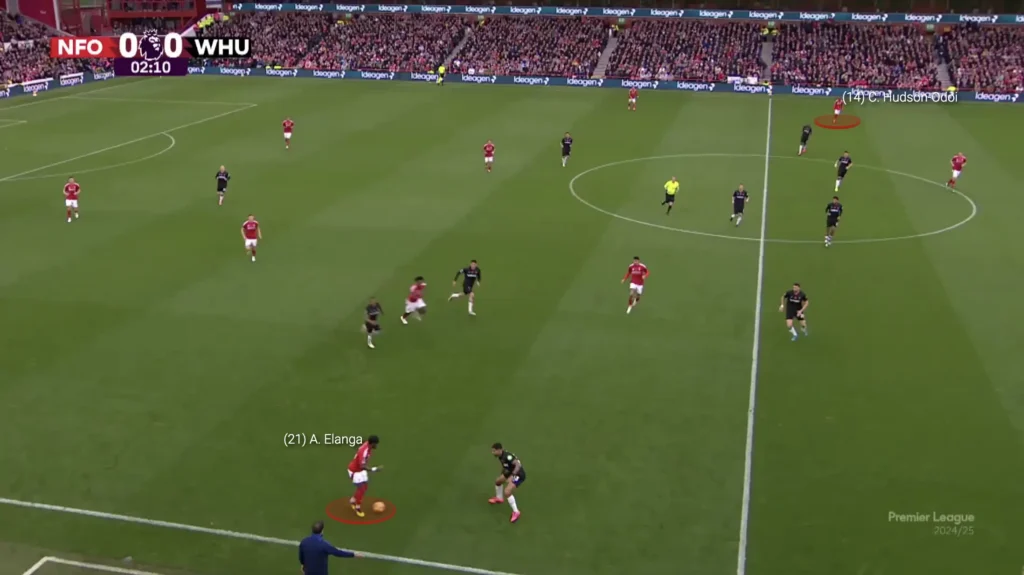
While players like Nicolás Domínguez and Elliot Anderson invert into the middle when playing as wingers.
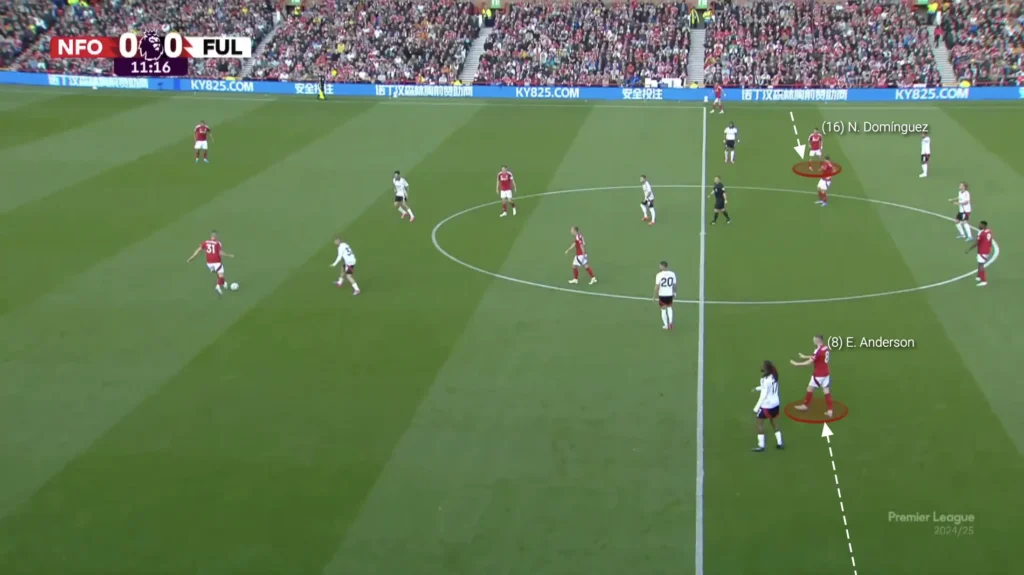
Espírito Santo also emphasizes versatility, with players interchanging positions and formations seamlessly to maintain possession and disrupt the opposition’s defensive structure. This flexibility creates numerical superiorities in different areas, allowing Nottingham to bypass the opposition’s press while maintaining control.
Nottingham Forest will, for example, often create a back three in the build-up. Their most common way to do this is to come in with one of the fullbacks next to the center-backs and push the other one up, either on the wing or into the midfield.
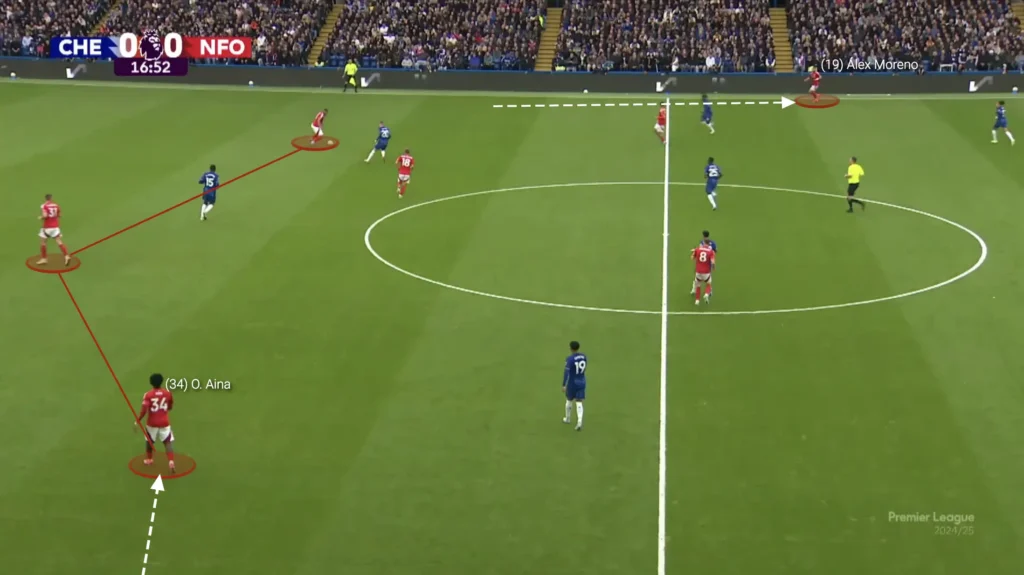
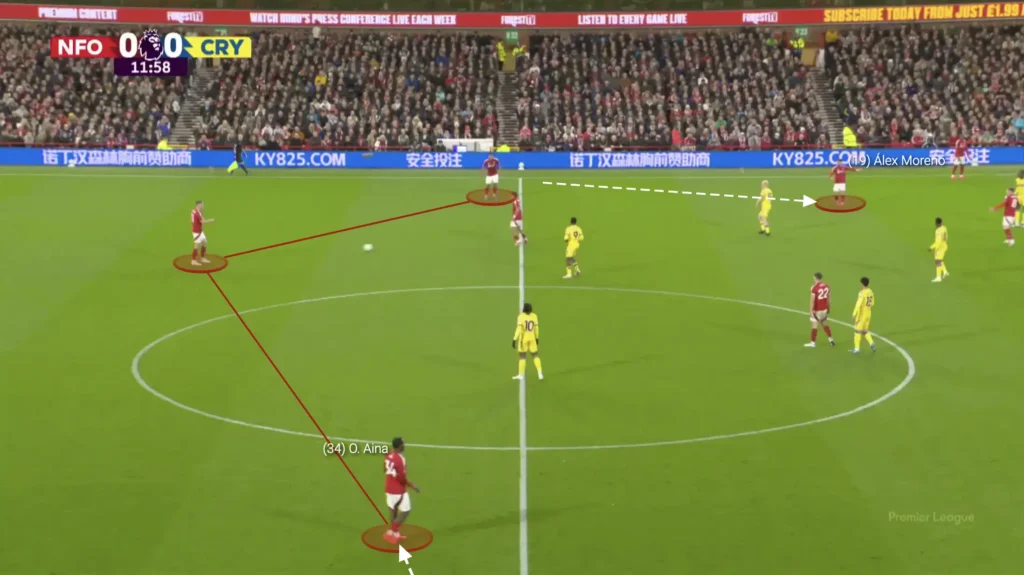
Espírito Santo has also dropped a holding midfielder down between the center-backs to create a back three in the build-up.
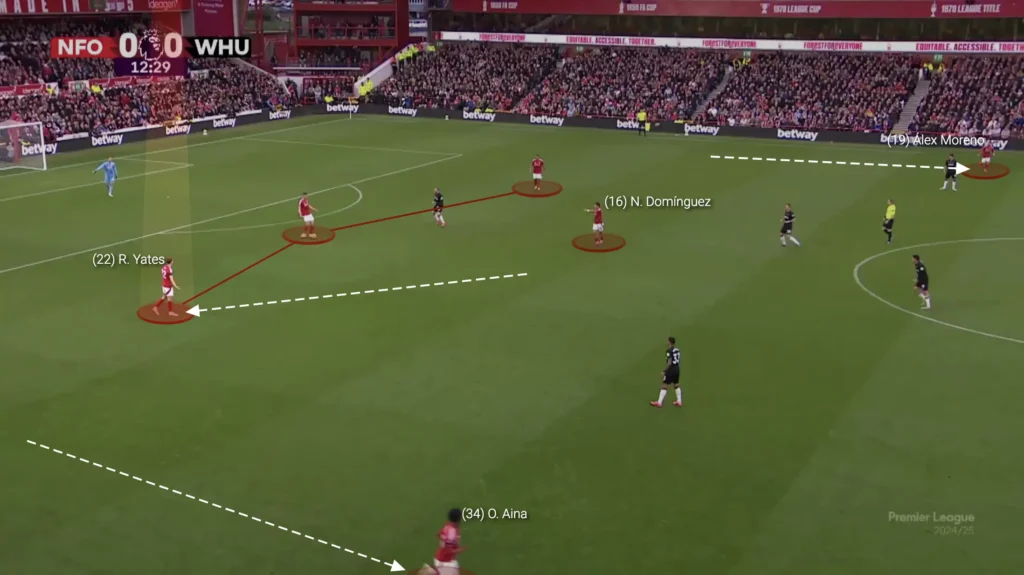
By creating a back three, Nottingham not only widen the field but also open up different angles for passing, making it easier to beat the opposition’s press. It also gives them more options in progressing the ball up the field and disrupts the opponent’s pressing structure, helping them maintain fluidity in their play.
While it demands a lot of technical and tactical skill from the players, this fluidity has created new dynamics for Nottingham’s attacking style, offering new solutions and ways of beating the opposition’s press.
Direct Build-up
Espírito Santo’s Nottingham Forest often takes a direct approach in their build-up play, frequently opting for early long balls to target striker Chris Wood. Rather than building through short passes, Forest’s strategy aims to bypass the midfield and immediately create pressure on the opposition’s backline. By sending early balls up to Wood, who is skilled in holding up play and winning aerial duels, they establish a platform from which Forest can quickly transition into attacking phases. This tactic not only leverages Wood’s physical presence but also keeps the opposition on alert, disrupting their defensive structure and allowing Forest’s supporting players to move into advanced positions.
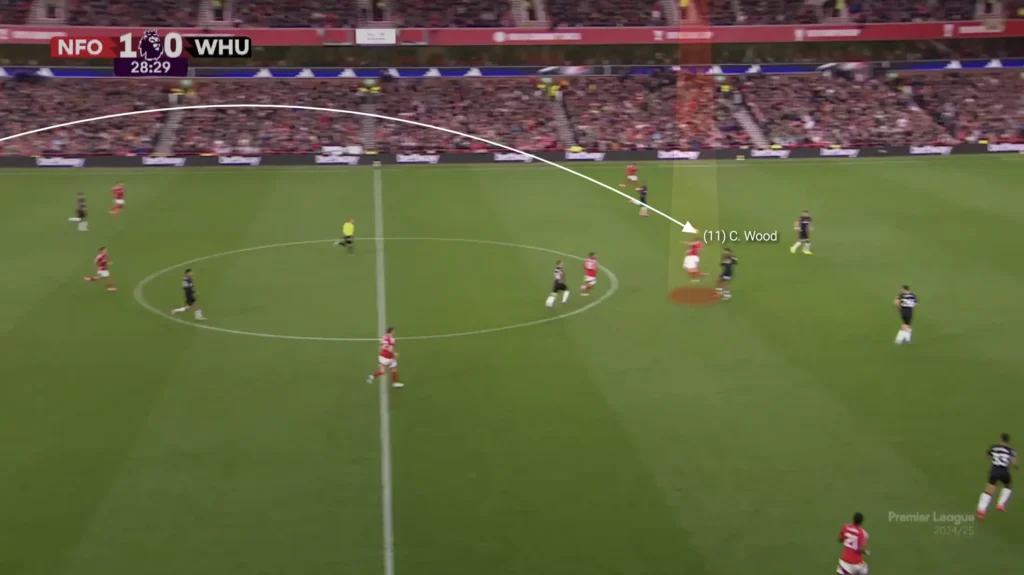
Building up like this offers minimal risk while allowing Nottingham Forest to quickly advance the ball and keep the opposition under pressure. It also maximizes Chris Wood’s strengths, enabling him to hold up play and involve his teammates higher up the field, creating fast-paced attacking opportunities.
In this situation, for example, Nottingham Forest progress the ball from the goalkeeper all the way into the opposition penalty area, only using two passes. The goalkeeper first plays a long ball up towards Wood. Wood holds off his defender and brings the ball down with control.
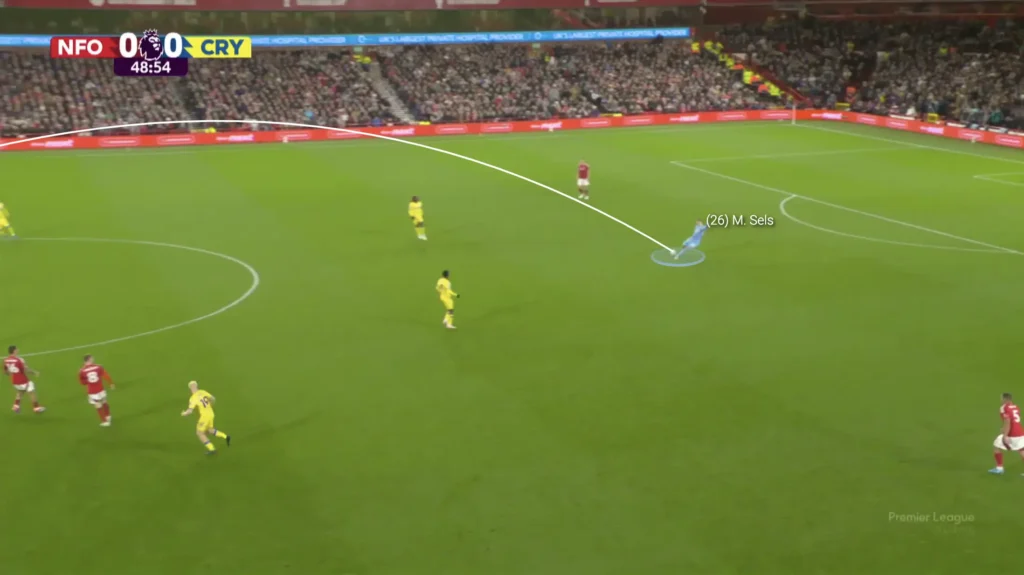
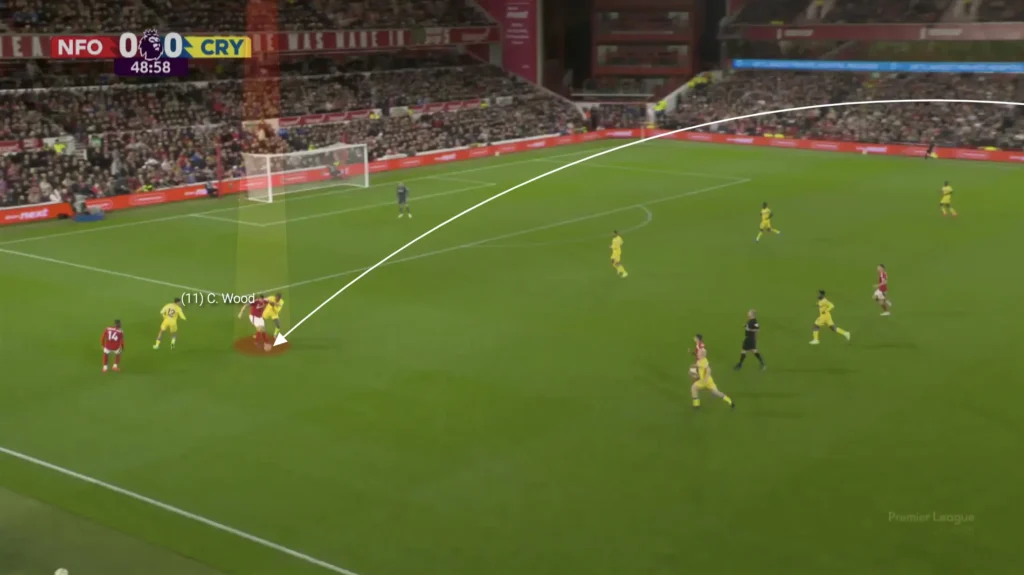
A Nottingham midfielder has pushed up and receives a pass from Wood, allowing him to drive the ball into the penalty area, creating a goalscoring opportunity.
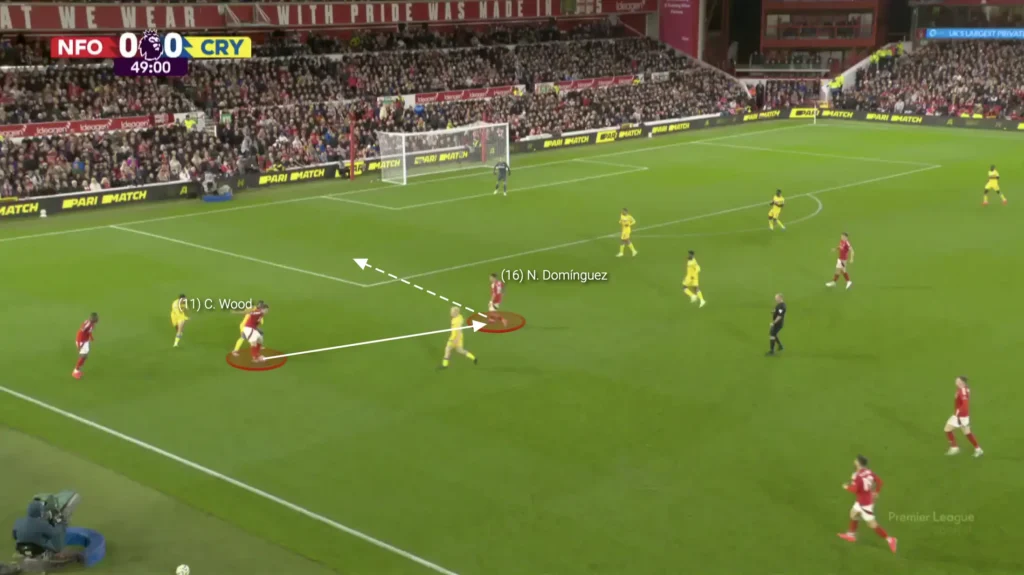
Linking with the Striker
Espírito Santo also uses Wood to link the play when trying to break down the opposition’s defense more methodically. He likes to create central overloads when attacking the opposition and, therefore, often wants Wood to drop from his striker position into the midfield. When the striker drops, Nottingham unlock more ways of beating the opponent’s defense. They can, for example, pass the ball to the striker, who can find a central midfielder behind the opposition’s midfield line, allowing the midfielder to take the ball forward and attack the opposition’s defense.
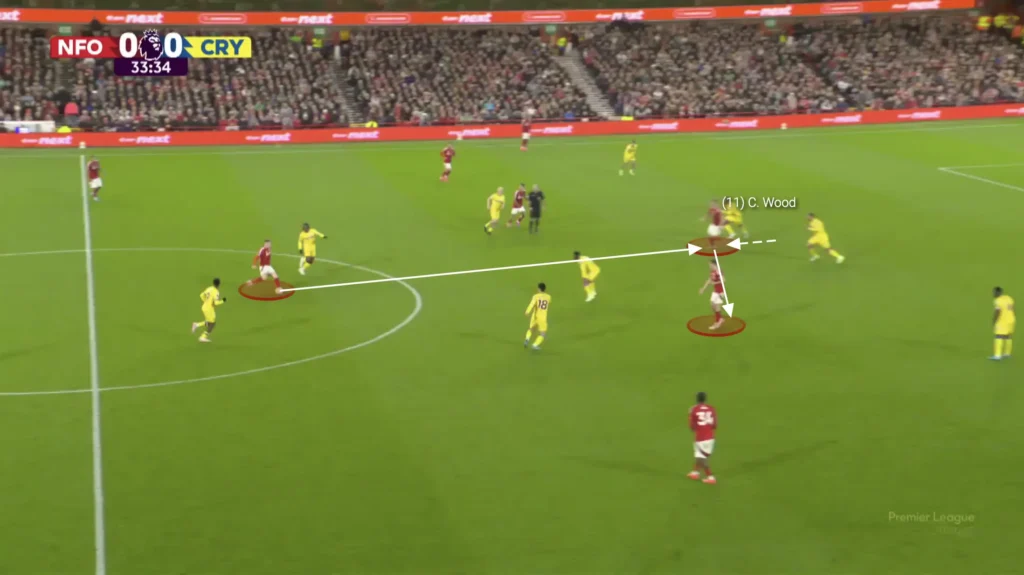
The striker dropping also creates a question for the opposition center-backs. If they step up on the dropping Chris Wood, the space behind them opens up, allowing Nottingham Forest to play a through-ball to a winger or midfielder, making a run in behind. However, if they stay in the backline to cover the run, the ball can be played to Wood, who can turn and attack the defense.
Nottingham’s second goal against Brighton comes from a situation like this. Wood drops at first to link the play, allowing Nottingham to find a central midfielder in between the lines.
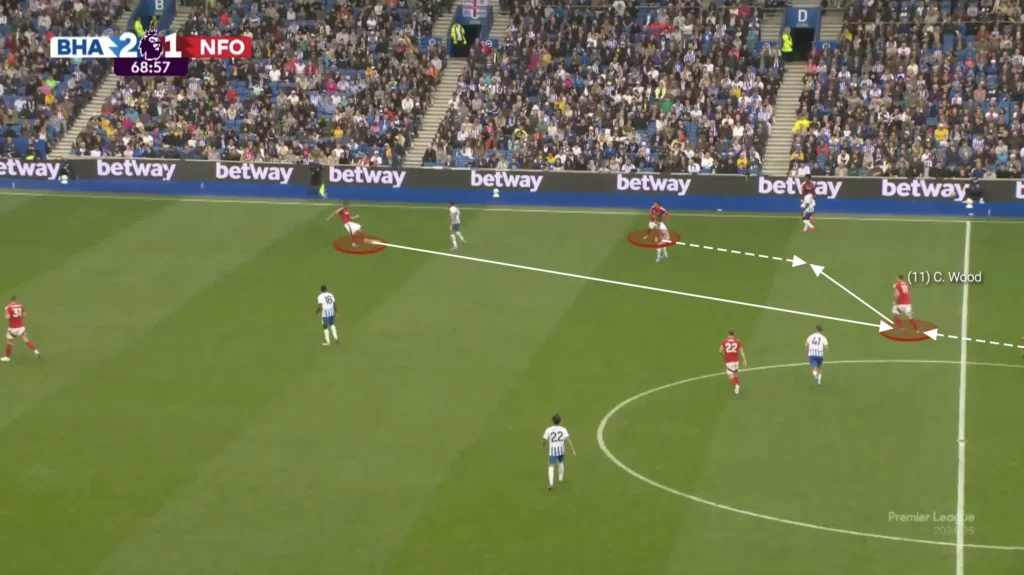
The Brighton center-back, Van Hecke, has pushed up on Wood, opening up big spaces in the Brighton backline. Nottingham Forest’s attacking midfielder, Jota Silva, makes a run into this space and receives a through-ball from the central midfielder. This gives Nottingham a 2v1 situation against Brighton’s goalkeeper, which they easily convert to score a goal.
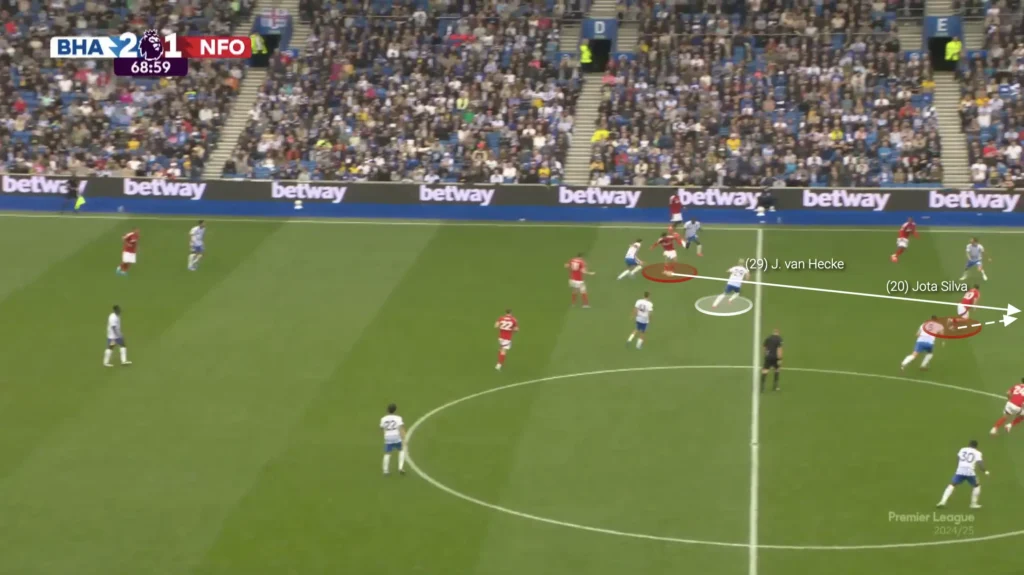

Final Third
Attacking the Half-Space
Espírito Santo’s players usually look to create chances by attacking the space between the opposition center-back and fullback. They primarily do this from the wide areas with underlaps from the attackers or midfielders. When the Nottingham winger receives the ball out wide, he will attract the opposition fullback. This opens the space between the opposition fullback and center-back, which allows a Nottingham player to make the underlapping run into this space. The ball can be played to the underlapping player, who can cross the ball into the box or attack his defender in a 1v1 situation.
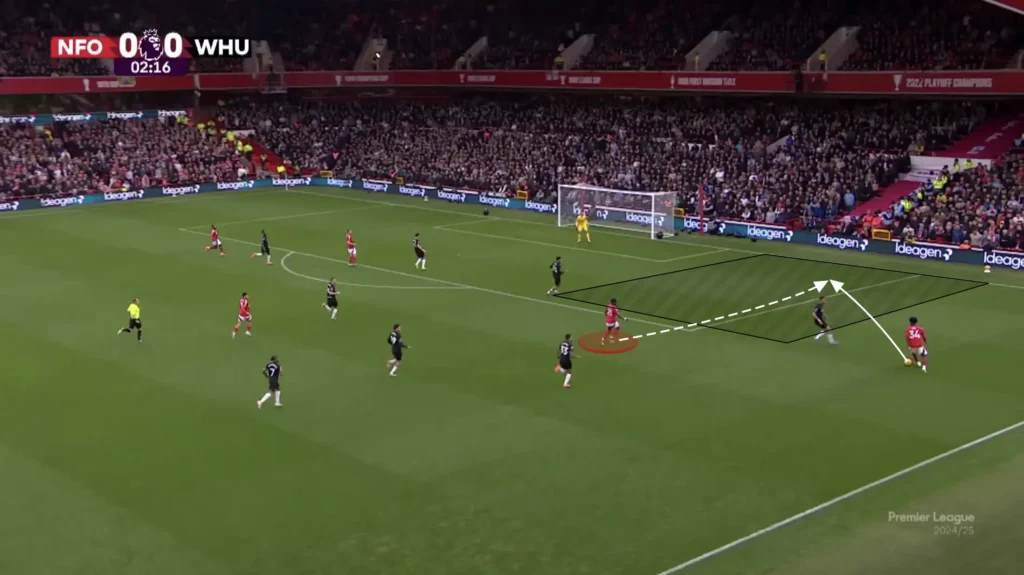
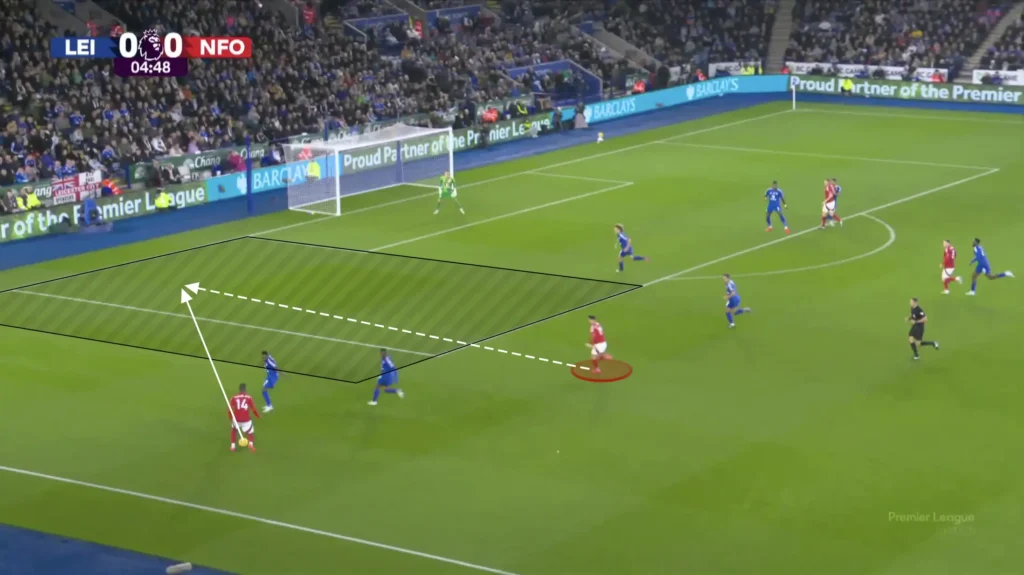
The winger does not have to play the ball to the underlapping player. The run from the Nottingham player will often drag away an opposition defensive midfielder, which opens the space inside. The winger can take the ball inside and shoot or find a pass to a free player in front of the backline.
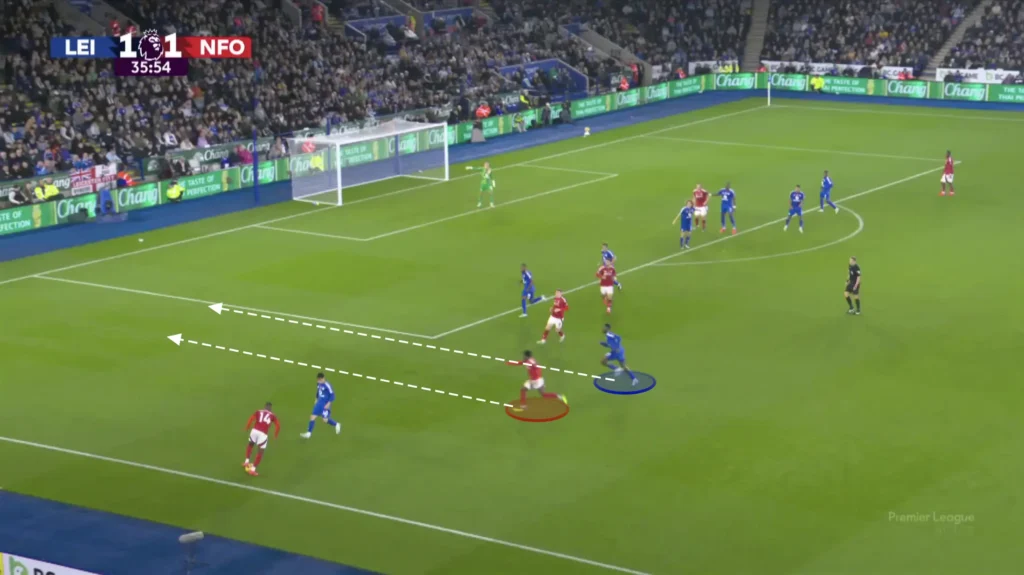
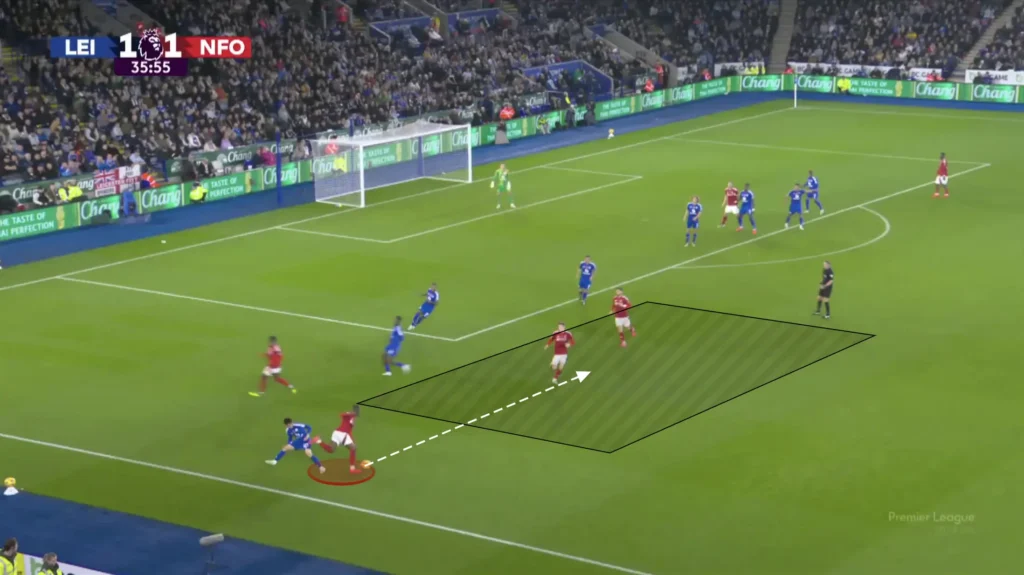
Overlaps
Nottingham Forest have also used overlaps as a key tactic to create goalscoring opportunities under Espírito Santo. This involves the fullbacks making forward runs to get around their winger, providing an extra attacking option on the flanks. By doing so, they create a 2v1 situation with the winger against the opposition fullback, which could be used to beat the fullback and create crossing opportunities.
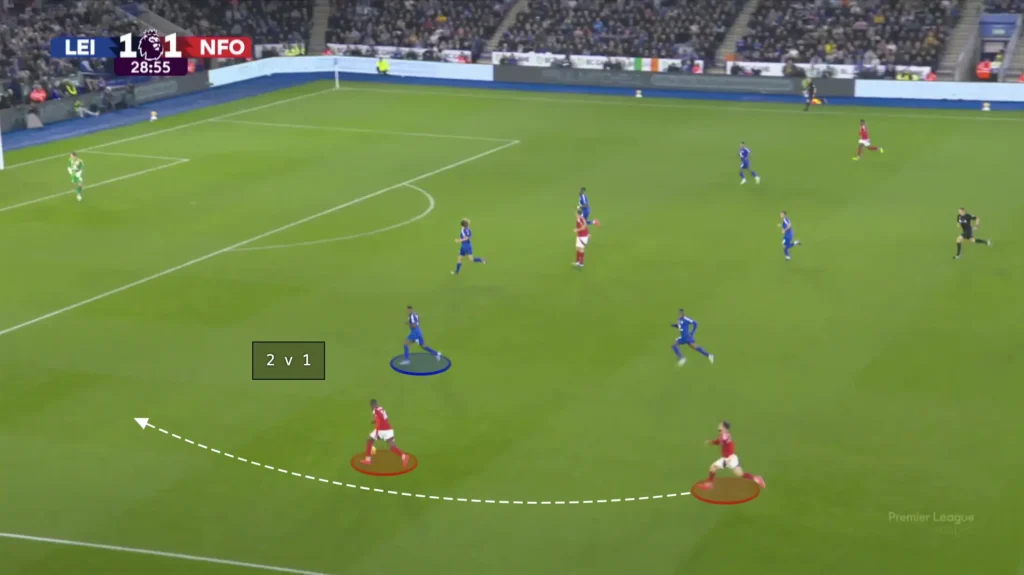
Nottingham’s wingers often initiate the play by attracting the opposition fullback, leaving space for an overlapping fullback to exploit. The overlap forces the defending fullback to make difficult decisions—either stick with the winger or follow the overlapping fullback. If the opposition fullback drops to cover the overlapping run, the winger could cut inside and take a shot or combine with a midfielder. If the fullback covers the center, the ball can easily be played to the overlapping player, creating a crossing opportunity.
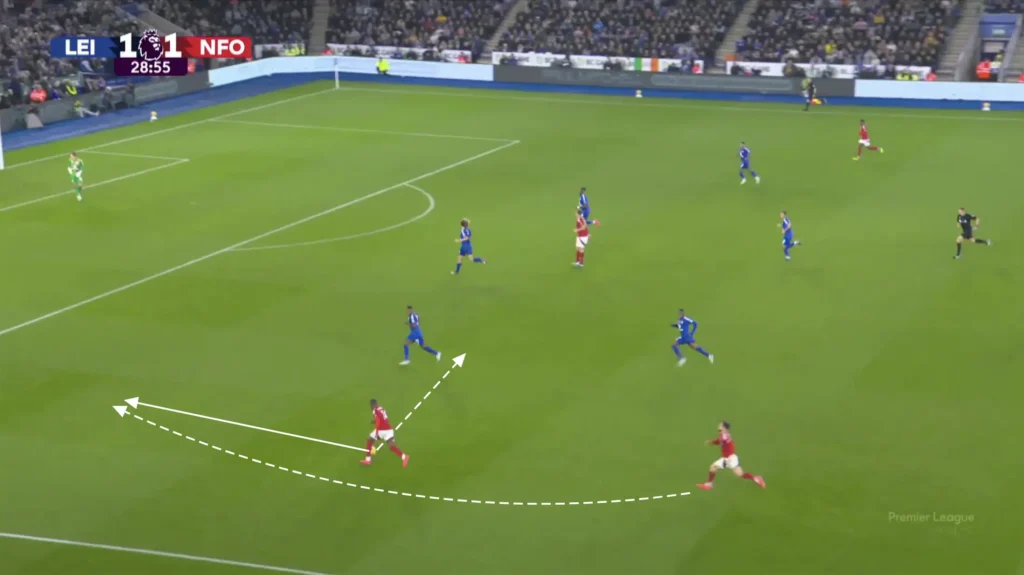
Many Players in the Box
Nottingham Forest consistently emphasizes getting multiple players into the box, creating a chaotic environment for defenders, and increasing their chances of scoring. The wingers, midfielders, and sometimes fullbacks look to make aggressive runs into the box when the ball is in the final third, often getting four or five players into these areas to create overloads.

The numerical advantages in the box increase the chances of connecting with the cross, as more players present multiple targets for the crosser, making it harder for defenders to mark everyone effectively. Additionally, having multiple players in the box provides options for different types of finishes, whether it’s a header, volley, or a quick tap-in. It also allows for better positioning to react to second balls or rebounds, increasing the likelihood of capitalizing on any defensive errors.
Espírito Santo also positions many players outside the box, ready for the second balls and cut-backs. Nottingham Forest will often create crossing opportunities, which pushes down the opposition’s defense and opens the space in front of the opposition’s backline. The central midfielders can collect any loose balls or be found directly in these spaces with cut-backs, and from there, they can shoot or combine with an attacker to create goalscoring opportunities.
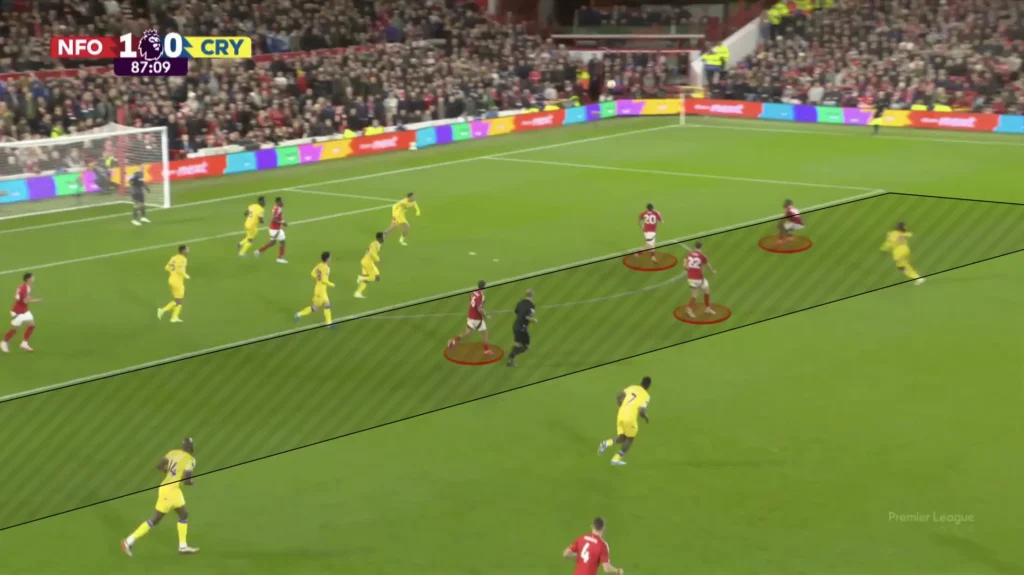
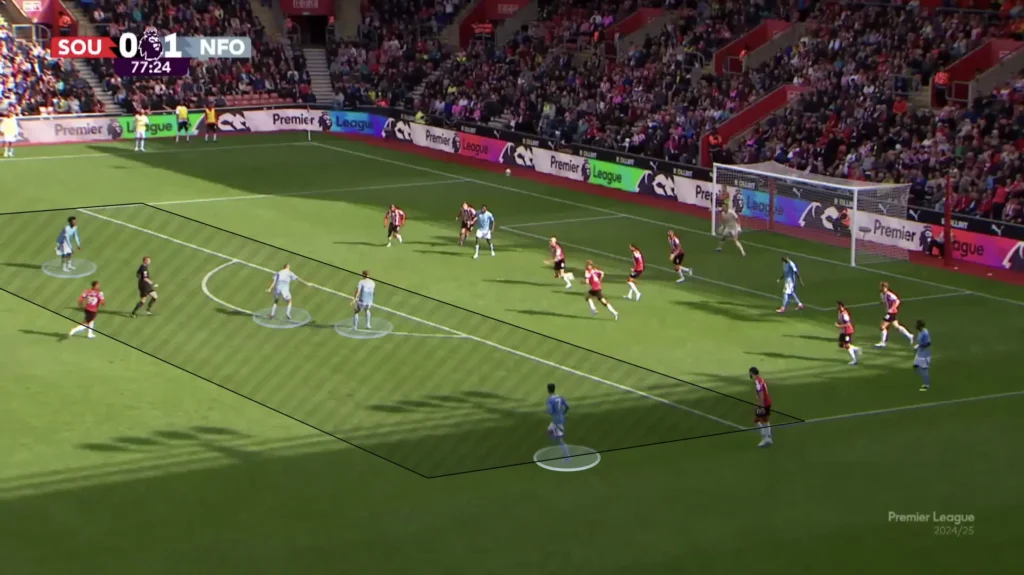
Defending
Mid Press
Nottingham Forest’s base formation when defending is the 1-4-2-4 formation. They look to set up in a mid-block, always trying to close the center and force the opposition out wide. Defending in a 1-4-2-4 formation requires a careful balance between pressing high and maintaining defensive solidity. The two central midfielders play a crucial role, acting as the primary shield in front of the back four while also supporting the press when the team looks to regain possession. The front four must press aggressively, cutting off passing lanes and forcing the opposition into mistakes. The back four stays compact, with fullbacks responsible for covering wide areas while center-backs maintain a solid shape. Overall, the success of defending in this formation hinges on coordinated pressing, quick transitions, and disciplined positioning to avoid being exposed in central areas.
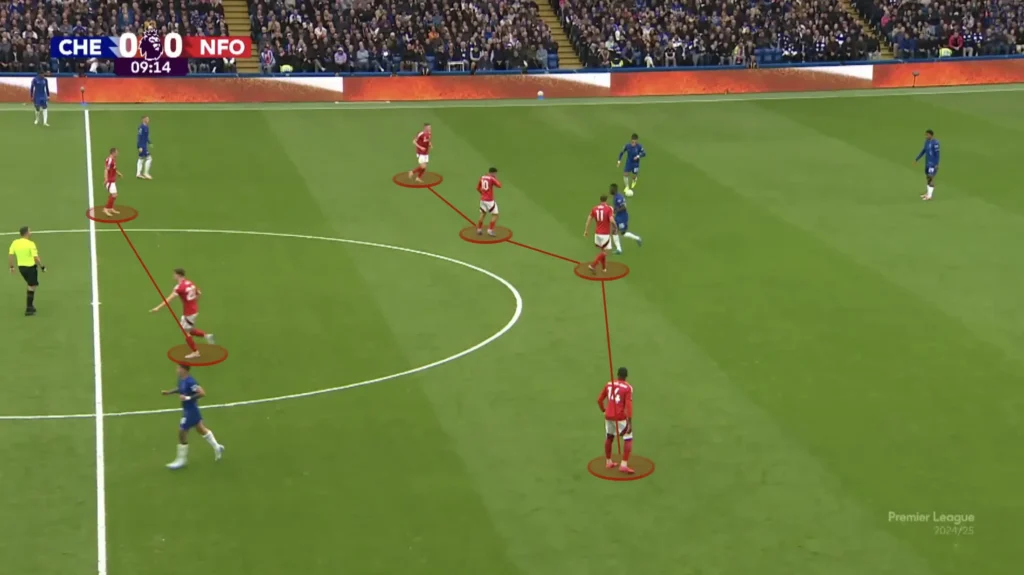

In Nottingham’s defensive system, the wingers will usually press the opposition center-backs while the strikers cover the opposition’s holding midfielders.
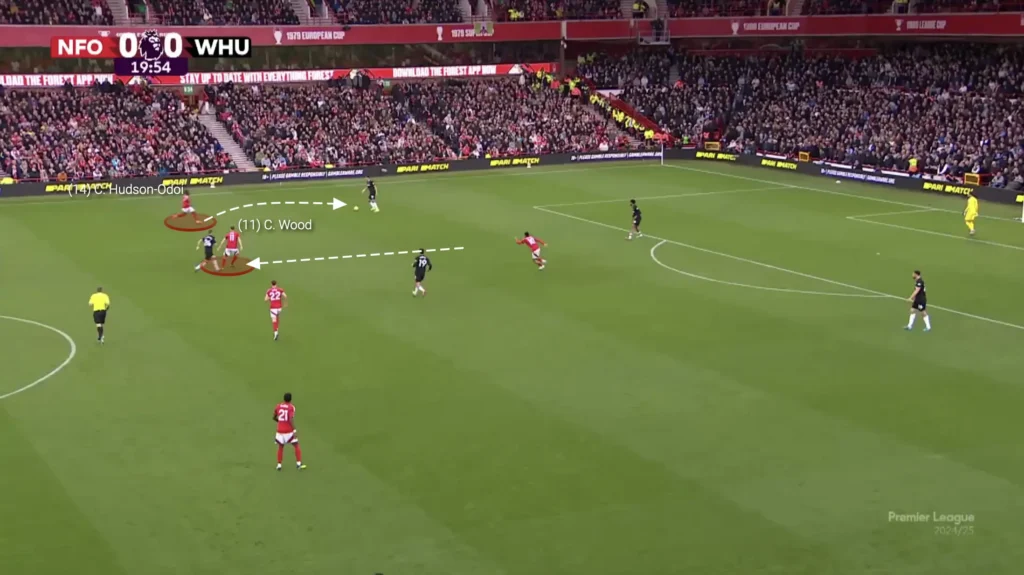
When the wingers press the center-backs, they close the passing lanes to the opposition fullbacks/wingbacks. This forces the opposition center-backs into the middle, where Espírito Santo wants to win the ball with the strikers, who block off all passes into the opposition’s midfielders.
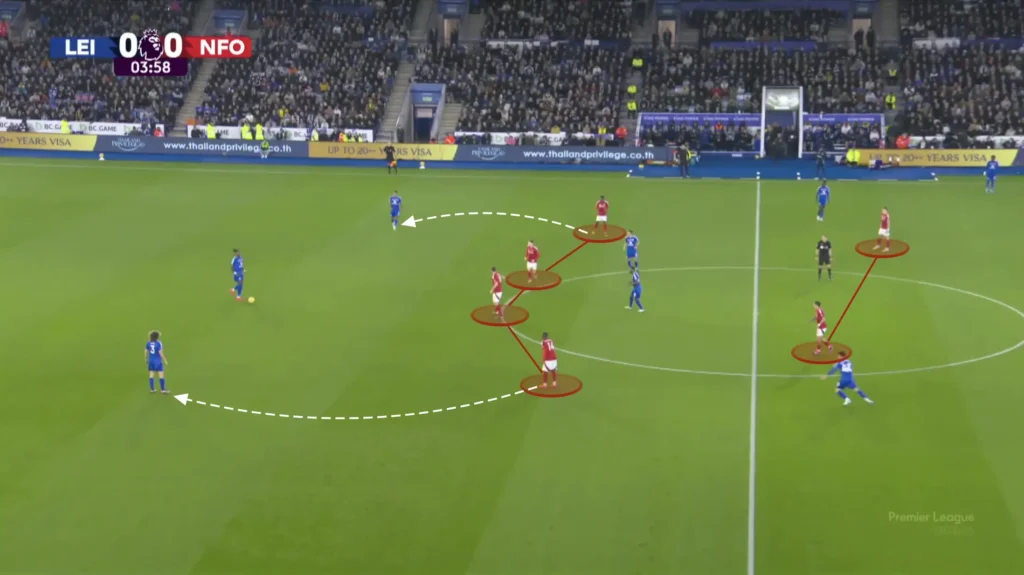
If the opposition moves the ball out to the side and tries to progress the ball through the flank, a central midfielder will break out to stop the opposition from advancing. If a central midfielder breaks out, the remaining midfielder must shift across while the strikers drop back even more, closing any passes into the midfield.
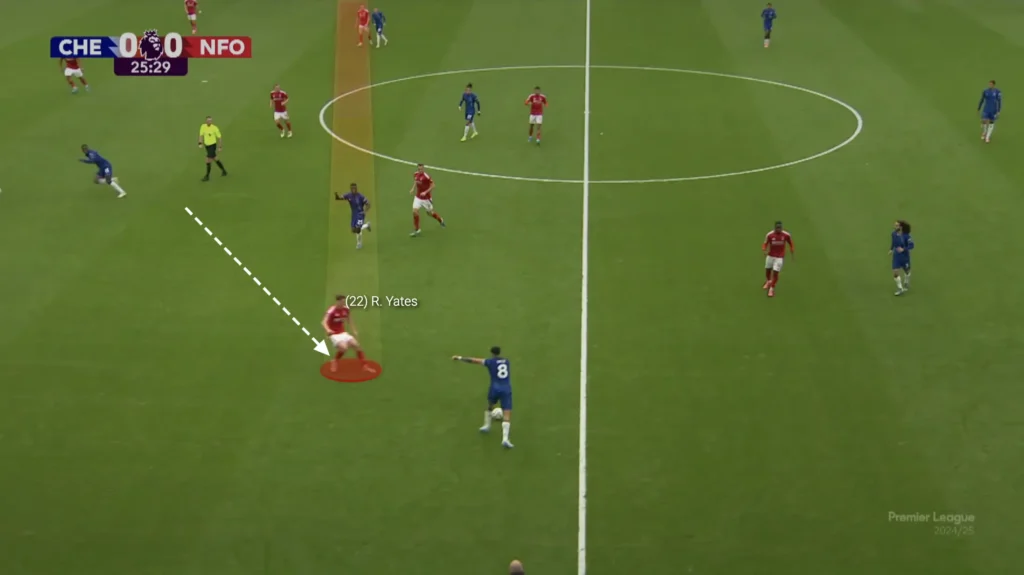
Low Press
When they get pushed lower down the pitch, Nottingham Forest will shift into a 1-4-4-2 formation, with the wingers dropping back into the midfield line.
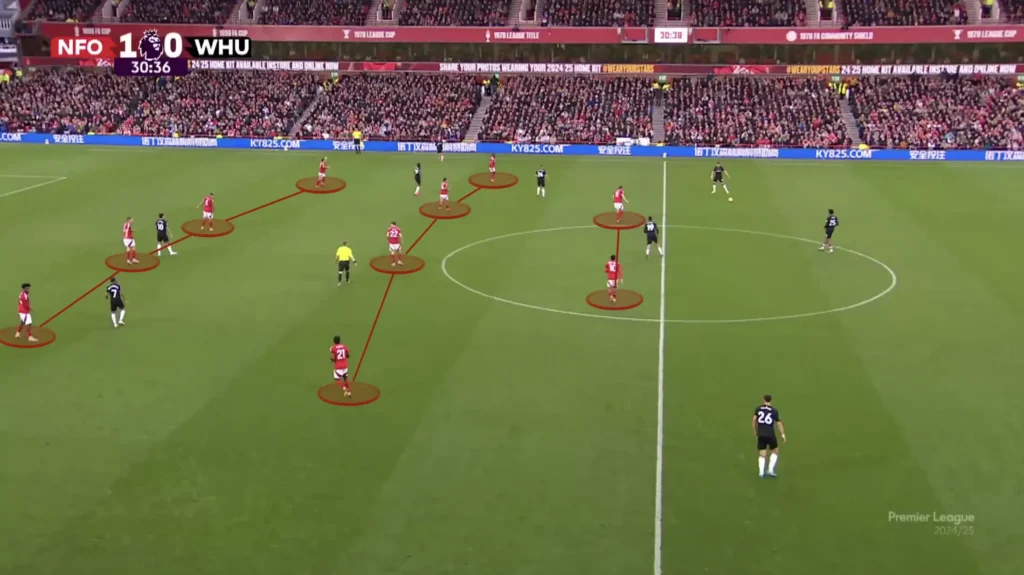
In this setup, the two banks of four stay tight and narrow, focusing on protecting central areas to force the opposition wide, where it’s more difficult to create high-quality chances. The two forwards remain in position to block passing lanes to the opposition’s holding midfielders, making it harder for the opposition to break lines. As opponents advance, Forest’s defenders and midfielders work together to maintain a disciplined shape, often closing down passing options and pressing at key moments without compromising their structure. This approach creates a defensive block that’s hard to penetrate, allowing Forest to absorb pressure while waiting for opportunities to counterattack.
When needed, Nottingham Forest shifts from the 1-4-4-2 into a 1-4-4-1-1 shape, with one forward dropping slightly deeper to support the midfield line.
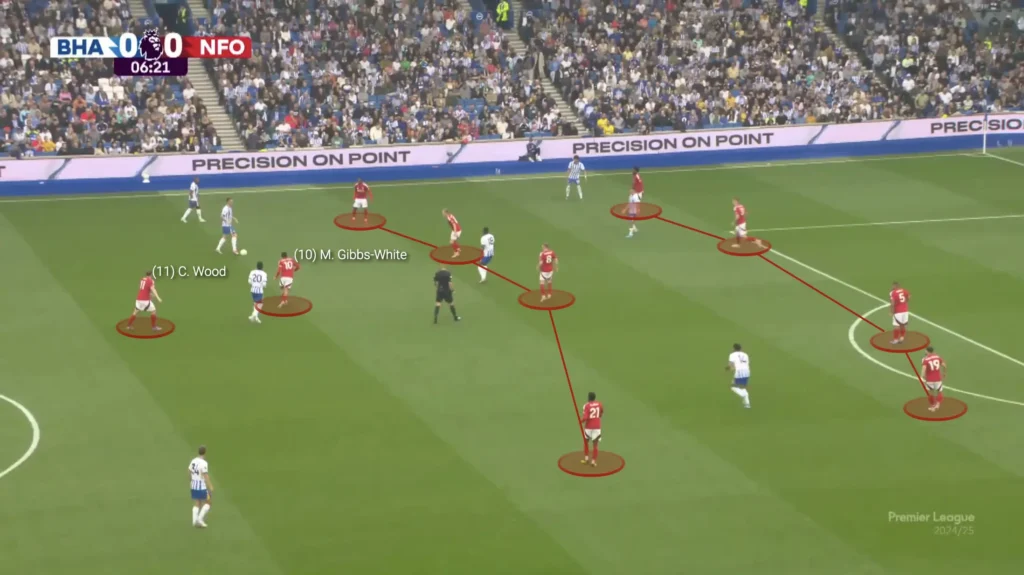
This extra layer strengthens their defensive shape, making it even harder for opponents to find space between the lines.
Work Rate
Nottingham’s work rate when defending is exceptional, defined by relentless energy and discipline. Under Espírito Santo, the team is organized and compact, with every player contributing to defensive duties. The midfield and forward lines press with intensity, closing down spaces and forcing opponents into uncomfortable positions. Nottingham’s backline remains focused, consistently tracking runs and maintaining their shape. When a defender breaks out of shape to put pressure on an opposition player, a Nottingham midfielder will always drop into the backline to cover for his teammate.
They will mainly do this to close the space between the center-back and the fullback. By having a central midfielder step into these gaps, Nottingham Forest create a back five, allowing them to maintain their defensive shape, prevent overloads, and provide additional cover for their fullbacks, especially when they are pushed out wide.
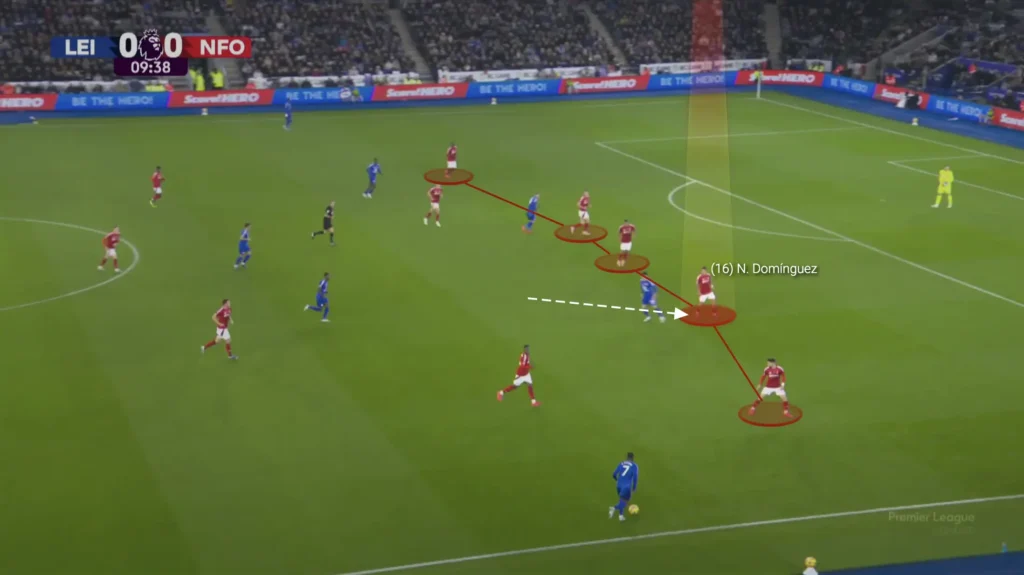
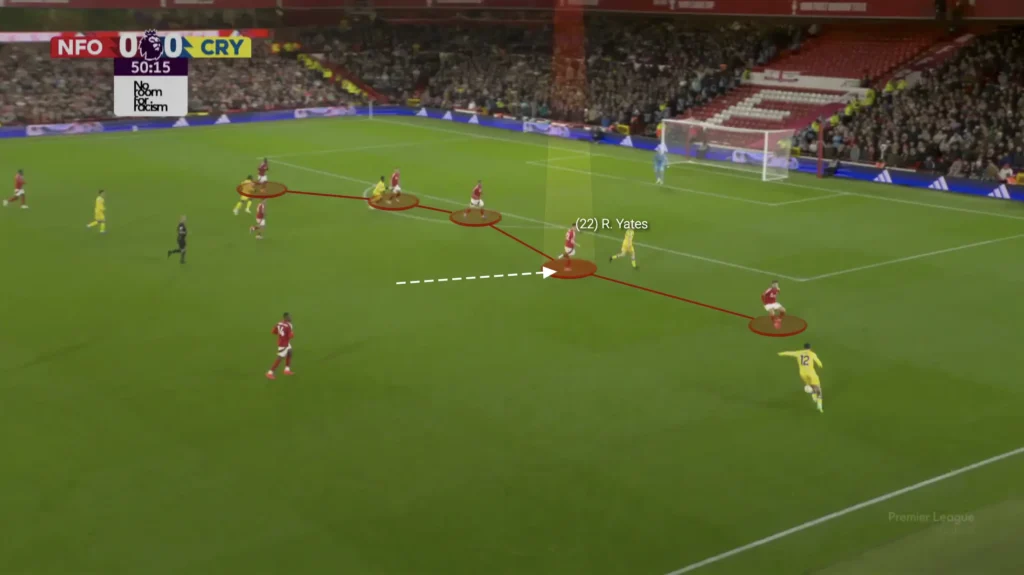
This compactness ensures that the team stays solid defensively, making it harder for the opposition to break through with wide or central attacks. Additionally, midfielders covering these spaces allow the center-backs to stay in the box in crossing situations.
Defending the Penalty Area
Nottingham Forest’s approach to defending the penalty area under Nuno Espírito Santo often involves committing a large number of players—typically eight—to create a dense, layered defensive structure.
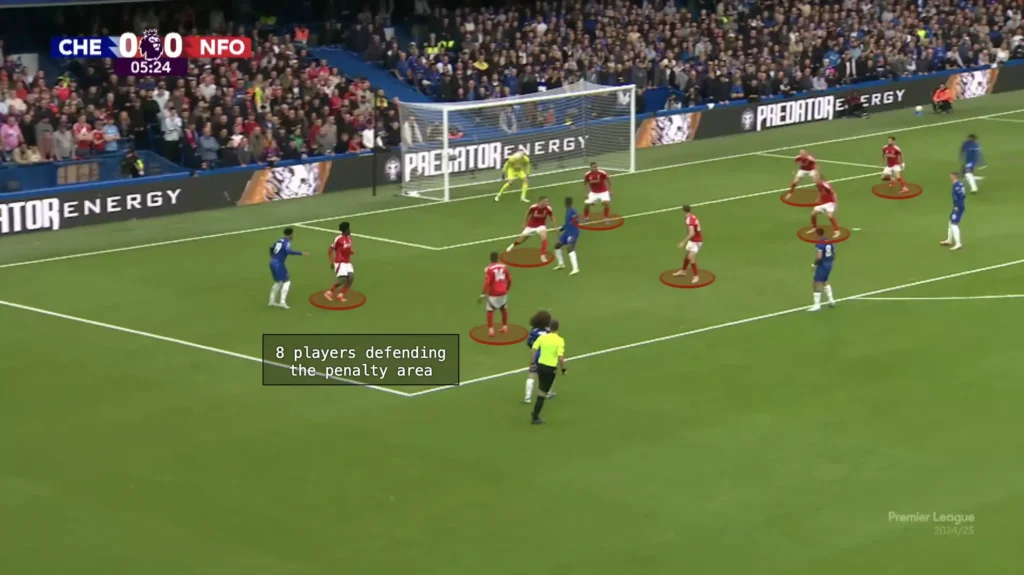
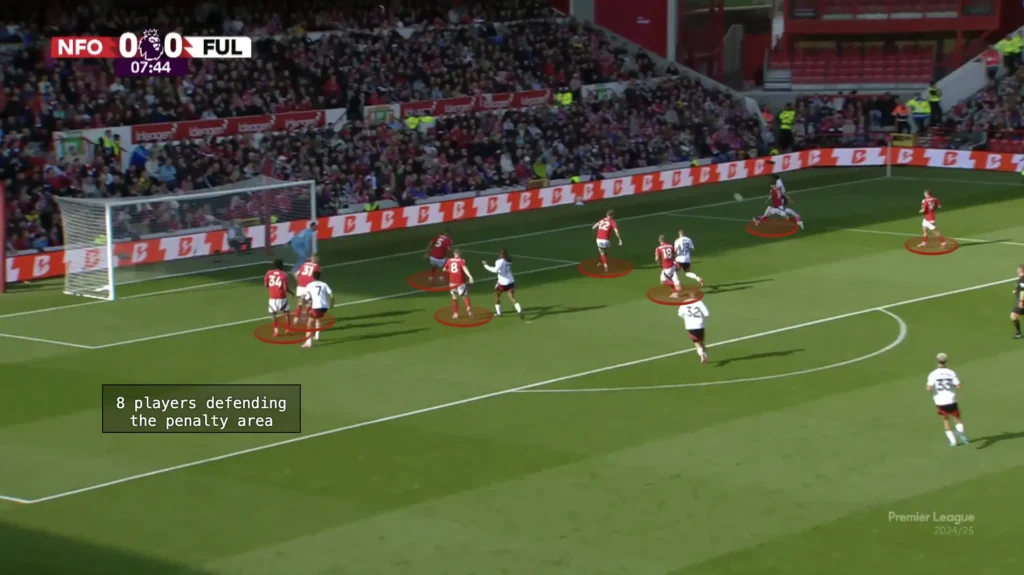
By bringing players back, Nottingham forms a compact low block that limits space for opposing attackers, making it challenging for them to find clear shooting angles or make penetrating passes. This setup includes two close lines, with midfielders dropping deep to support the defensive line, ensuring minimal gaps between defenders. The approach emphasizes blocking shooting lanes, crowding the box, and forcing opponents to rely on low-percentage shots from distance or wide areas, where Nottingham can recover possession and quickly transition forward.
Squeezing the Pitch
To prevent his team from becoming too low when defending, Espírito Santo wants his team to squeeze the pitch. This means constantly pushing the team up as much as possible. Every time the opponent plays a slow, sideways pass or a back pass, Nottingham’s first line of pressure pushes up, with the rest of the team following to stay compact. When the next pass comes, they push up even more, forcing the opponent back even more.
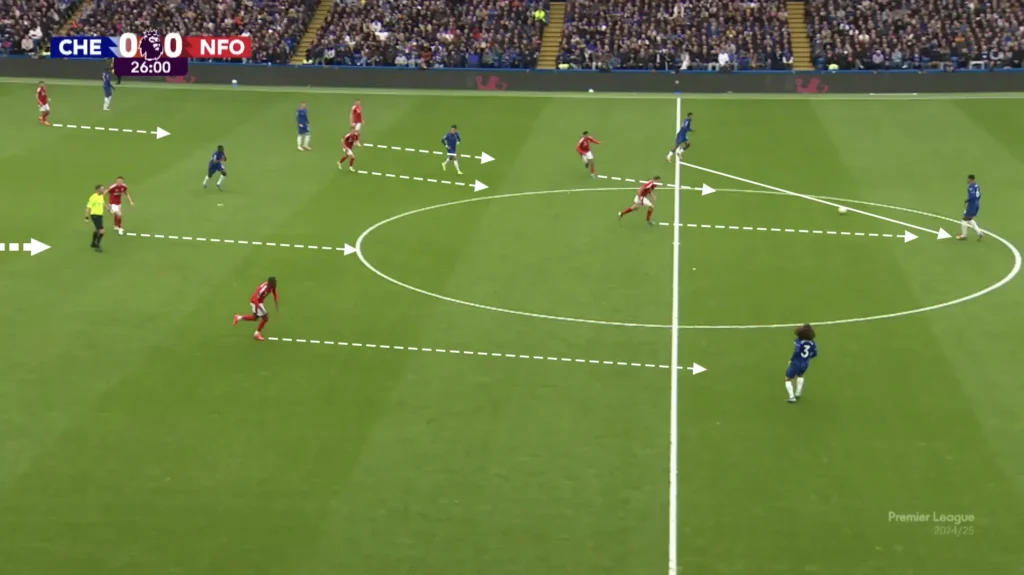
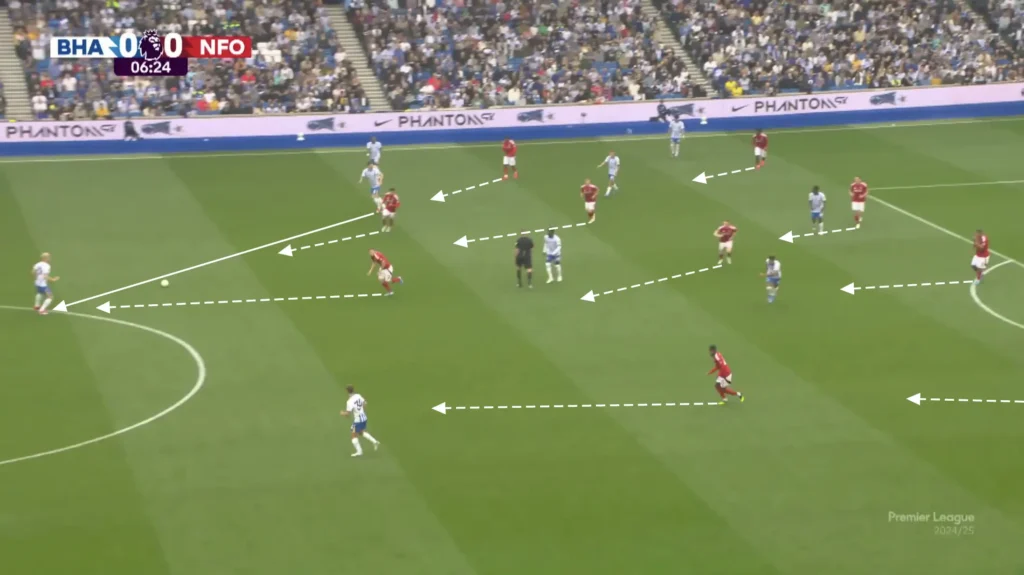
This approach keeps opponents under constant pressure, making it difficult for them to build rhythm or find space between the lines. It also pushes the opponent further away from the Nottingham Forest goal, making it harder to create chances.
Transitions
Defensive Transitions
Nottingham Forest are great in defensive transitions. In possession, they always have many players high up and close to the ball, which creates good conditions for counterpressing. Many players close to the ball after losing possession means that many players can work towards regaining possession. Espírito Santo’s players are also very aggressive in the first seconds after losing the ball. The four or five players closest will immediately jump on the opposition player with the ball and close the distance to cut off any passing lanes. This approach disrupts the opponent’s transition from defense to attack, forcing errors and creating opportunities to regain control in dangerous areas.
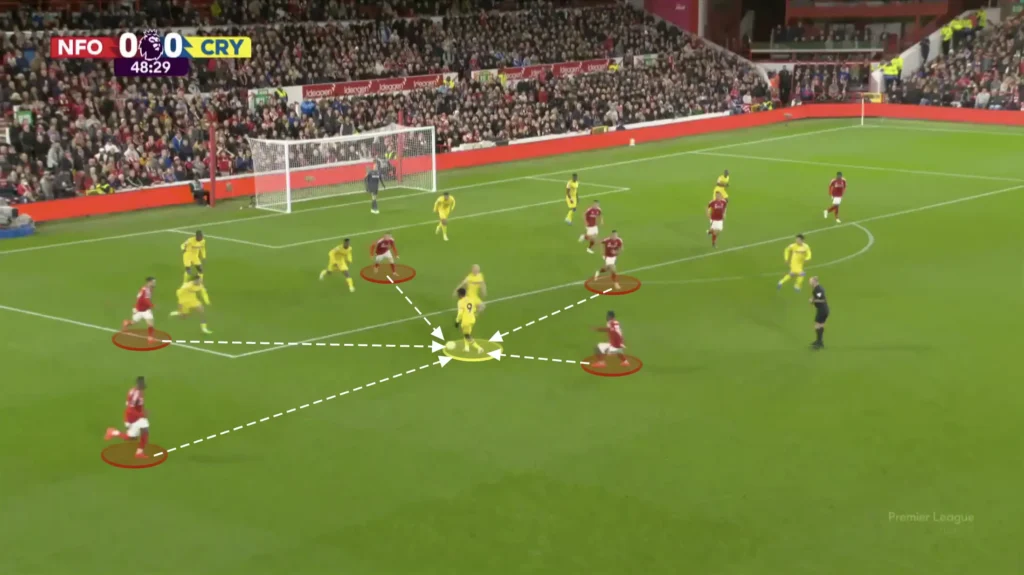
Counterpressing like this keeps Nottingham Forest on the front foot, allowing them to dominate possession and create more scoring opportunities. However, it requires exceptional fitness, tactical discipline, and teamwork.
Offensive Transitions
Espírito Santo also wants his team to counterattack in their offensive transitions. When winning the ball, the team transitions quickly from defense to attack, utilizing the speed and movement of their forward players. Espírito Santo emphasizes vertical passes to exploit spaces left by the opposition, often targeting wide areas or gaps between defenders. Nottingham’s counterattacks are well-organized, with players making intelligent off-the-ball runs to create overloads and support the ball carrier. This quick, direct style catches opponents off guard, making Nottingham a dangerous team on the break.
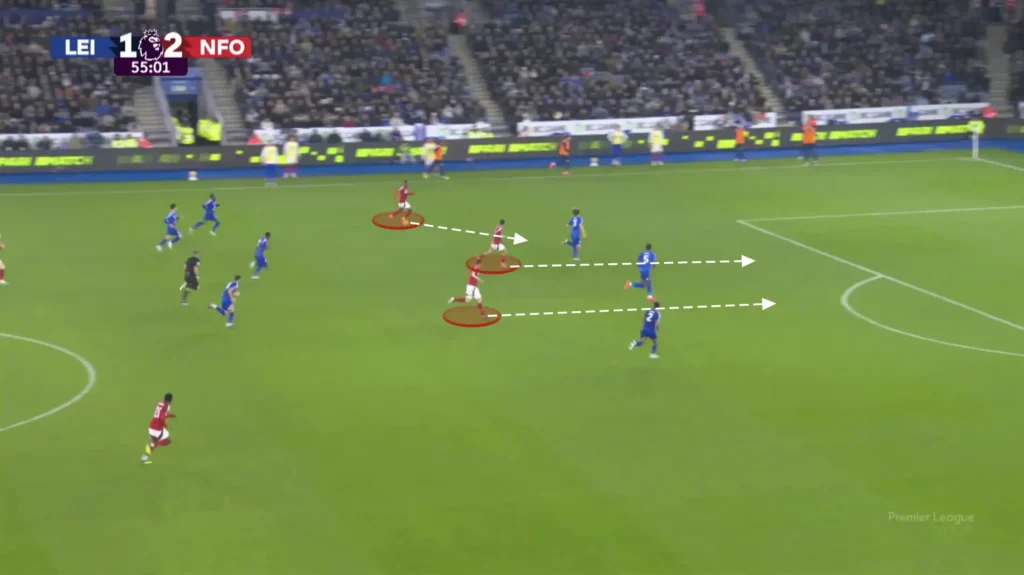
Additionally, the Nottingham players are great at finding open spaces in the counterattacks. Instead of playing the ball straight forward where opposition defenders may still be positioned, they play a diagonal pass, allowing the team to bypass pressure and shift the play into open areas. From these areas, the Nottingham attackers can take the ball forward and quickly get past the opposition to create a goalscoring opportunity.
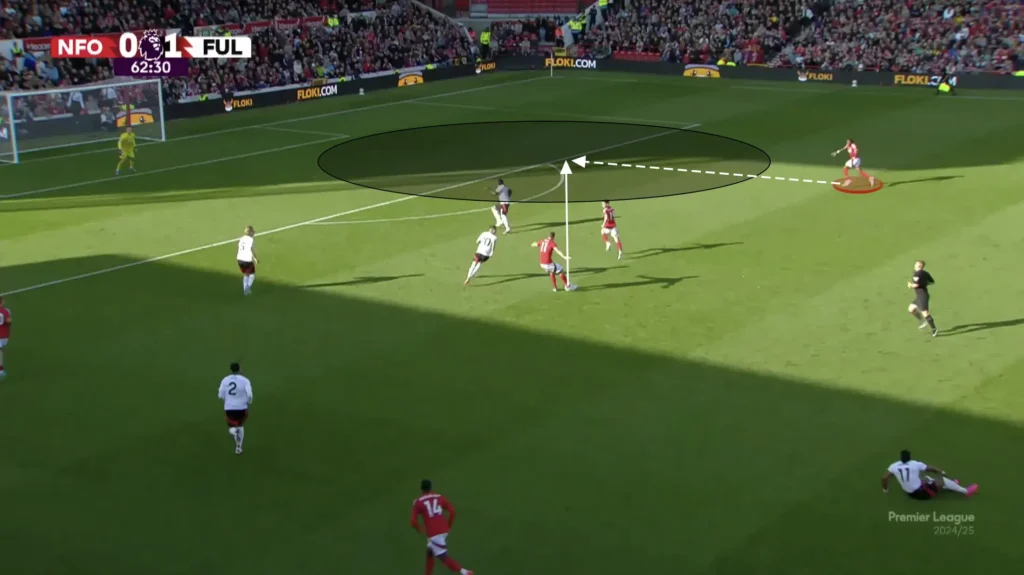
Nottingham Forest’s aggressiveness also means they have many players high up when defending, which enables them to incorporate more players into the counterattacks.
Final Thoughts
In conclusion, Nuno Espírito Santo’s influence on Nottingham Forest’s tactics is becoming increasingly clear. His approach blends structured defensive resilience with selective offensive opportunities, creating a team that is difficult to break down and capable of capitalizing on counterattacks. The use of fluid formations, compact midfield, and well-timed pressing reflects his trademark strategies, designed to maintain control and frustrate opponents.
Nuno’s tactical philosophy brings a disciplined, adaptable edge to Nottingham Forest, allowing the team to navigate matches strategically and exploit chances when they arise. As his ideas take root, Forest supporters can look forward to a season where strong organization and calculated play define the club’s performances. This tactical blueprint positions Nottingham Forest as a formidable opponent and one that’s primed to adapt and compete effectively under Nuno Espírito Santo’s direction.
